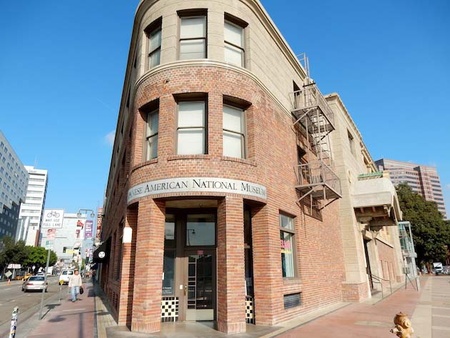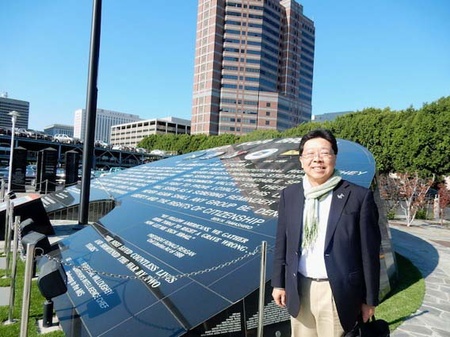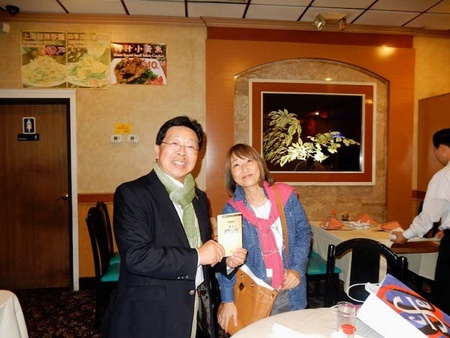In October 2014, I finally made the long-awaited trip to Los Angeles and had the chance to visit the Japanese American National Museum, which I have been a frequent visitor to for some time. This museum not only houses materials and exhibits related to Japanese Americans, but is also the largest museum for Japanese Americans, housing materials, columns, testimonies, photos, and videos on Japanese immigration to the Americas1 .

Japanese immigration to America began in 1868 with the Hawaiian immigrants (then still a kingdom, later annexed to the United States). The 148 immigrants traveled to Hawaii under individual contracts, without the Meiji government's permission to leave. The labor conditions were so harsh that some of them later returned to Japan through negotiations with the Japanese government, while many were relocated to various parts of the West Coast.2
At the time, foreigners were not allowed to purchase land or apply for naturalization in California, and the first generation had to rent land or transfer it to the name of their American-born second generation children. Nevertheless, they cultivated strawberries, rice, onions, asparagus, potatoes, and other crops on a scale of thousands or tens of thousands of hectares. According to a study by Professor Takeo Yamamoto, Japanese farmers in California had a surprisingly large share of vegetable and fruit cultivation. In 1939, in Northern California, Japanese farmers accounted for 97% of strawberries, 82% of onions, 59% of celery, 45% of asparagus, 36% of potatoes, 25% of green vegetables, 21% of tomatoes, and 17% of lettuce, while in Southern California, they accounted for 97% of green vegetables, 96% of cauliflower, 93% of strawberries, 92% of celery, and 83% of tomatoes. The professor emphasizes that this development was the result of the efforts, hard work, unity, and support of Japanese Americans, and that they have made a great achievement.3 Japanese immigrants made it possible to supply large amounts of agricultural produce, which was shipped both within and outside the state, but this no doubt also increased the jealousy of non-Japanese people.
Keizaburo Koda, a Fukushima immigrant who was known as the "Rice King," owned 10,000 acres (equivalent to 4,000 hectares) of land before the war and cultivated rice, which shipped out millions of dollars a year. 4 During the war, he was interned at the Amache Internment Camp, but after the war he won a lawsuit against the authorities for selling his land without permission. With the funds he gained, he cultivated rice on a large scale and developed "KOKUHO ROSE," which is still one of the most famous brands of California rice. He also worked hard to win the right to naturalize foreigners by challenging the constitutionality of the Alien Land Law, and contributed to improving the status of Japanese Americans in American society (1882-1964).
Initially, my image of Los Angeles was superficial, influenced by TV and movies, such as Hollywood, Beverly Hills, Hispanic society, Little Tokyo, Asian communities, beautiful beaches, etc. I thought the international airport would be heavily guarded because of the large number of immigrants, but I entered the country very smoothly, even though I was coming from Guadalajara, Mexico. After all, Los Angeles has a large number of flights to and from Latin America, and is home to the largest Hispanic community in the United States5 . Los Angeles, with a population of 3.8 million, is the main city of California (population 38 million), but the state capital is actually Sacramento. Even though it is called Los Angeles, if you include Los Angeles County, the population is 10 million, and the proportion of Hispanics is about 40%. Next time, I would like to explore the residential areas of the Latin American community a little more.
Although this was a private visit, I paid a courtesy visit to the Japanese American National Museum, which has always been kind to me, toured the museum, had dinner with the staff, and was shown around the city, Hollywood, and Beverly Hills. I also went to the Go For Broke Monument, a memorial to the 442nd Regimental Combat Team, which was erected near the museum and was made up entirely of Japanese Americans who fought heroically on the European front during World War II, to pay my respects and offer a prayer.

As a result of the war with Japan, not only Japanese immigrants but also some of the second generation born in America lost their jobs and assets, and 120,000 were sent to 11 internment camps.6 In the midst of such injustice, the second generation volunteered to serve in the U.S. government, and as a result, the 442nd Regiment was formed, composed entirely of Japanese Americans. They performed well in training, and were involved in the most dangerous missions on the European front, and showed unquestionable loyalty and courage as soldiers, even though they made high sacrifices. On the Asian front, as part of intelligence, they worked in a unit called MIS, translating Japanese documents, wiretapped communications, interrogated prisoners, and infiltrated the country. During the Okinawa landing operation, some Japanese soldiers fought against their own brothers, sisters, and relatives, but they desperately called for their surrender. In every battlefield, the Japanese soldiers' greatest goal was to end the war as quickly as possible with their own achievements, release their parents and siblings held in captivity on the U.S. mainland, clear their name as enemy foreigners, and return to normal life. Even though the situation was unreasonable, they attempted to restore their loyalty and honor to their country in the ultimate battlefield of war.
Before going to Los Angeles, I read books and watched DVDs about Japanese-American troops, including "Two Homelands" by the late author Toyoko Yamazaki. I also paid a courtesy visit to and met Yukiko Yanagida, author of "Nisei Soldier: Records of Fierce Battles - Japanese-Americans' Second World War" (Shinchosha, 2012), a Los Angeles resident.7
Although Japanese Americans and their descendants share similar occupations and social backgrounds as Japanese who emigrated to Central and South America, their fates and trials during World War II were incomparably harsher. When President Truman praised the unit for its achievements, he said, "You fought the enemy and prejudice, and you won both," and this is certainly true. After the war, the battle continued in the legal and political arenas, and it was not until the Reagan administration that an official apology and compensation was made, and the unit was also socially recognized as the strongest in the U.S. Army.8
On May 1st of this year, Prime Minister Abe visited Los Angeles and after touring the Japanese American National Museum, he laid flowers at the Japanese American Military Memorial, an act that touched and thanked the Japanese American veterans.
There are 280,000 Japanese people in California, and if mixed race people are included, the number rises to nearly 400,000. California has the largest number of Japanese people in the United States, but what is unique about the state is that there are many people from other Asian countries as well as Hispanics.9 Amid this diversity, many Japanese people are still active today, and my visit to Los Angeles made me realize that we Japanese people from South America have a lot to learn from them.
Notes:
1. http://www.janm.org
With support from the Nippon Foundation, they run a website called Discover Nikkei , which features topics, history, events, and experiences from Nikkei communities around the country, and many columns can be viewed in English, Spanish, Portuguese, and Japanese.
2. The immigration agreement between Japan and the United States was concluded in 1885, and since then the number has increased, reaching approximately 30,000 by the end of the 19th century. Meanwhile, the number of Japanese immigrants to California also increased, and around 1900 immigration restrictions began to be put in place. Nevertheless, thanks to the invitation system, large Japanese communities had formed by 1940, with the number growing to over 150,000 in Hawaii and 120,000 on the West Coast. The total number in the United States was over 280,000.
3. Yamamoto Iwao et al., "Japanese-American Culture in North and South America," pp. 117-118, Jinbun Shoin, 2007.
Discover Nikkei also features many articles by Takeo Yamamoto .
You can also see Ryusuke Kawai's column: Japanese Americans in Southern California - Part 1
In California, the Alien Land Law did not allow foreign settlers to purchase land.
4. Akemi Kikumura Yano, The First Generation of Pioneers: History of Japanese Immigration in Hawaii and the Mainland United States 1885-1924 — Part 11
5. The Hispanic population in America has exceeded 50 million, overtaking blacks to become the largest minority. 64% are from Mexico, 25% are from the Caribbean and Central America, and the rest are immigrants from South America. There are 11 million illegal immigrants, and bills have been submitted on how to legalize or deport this population, but Congress has been unable to reach an agreement. In California alone, it is said that 2.8 million people from Central and South America are illegal immigrants. In the city of Los Angeles, Hispanics already make up 46% of the total population.
6. Japanese American National Museum Website: Overview of Japanese American Internment Camps
The museum's Discover Nikkei website has many articles and essays in both English and Japanese about Japanese American internment camps and the Japanese American military.
7. Yukikazu Nagashima, " Yukiko Yanagida's 'Nisei Soldiers: Records of Fierce Battles': A Story of World War II Written Through Testimonies ," Discover Nikkei, March 2013.
http://www.yukikoyanagida.com/
8. Although it suffered a high casualty rate due to its sacrifice and bravery, it is the most highly decorated Army unit in history. In October 2010, President Obama welcomed some of the veterans to the White House and announced that he would award the Congressional Gold Medal, the highest award given to a civilian, to all members of the unit (442nd Regiment, 100th Infantry Battalion, and MIIS).
9. Japanese Consulate General in Los Angeles website
© 2015 Alberto J. Matsumoto








